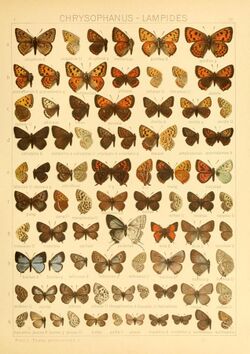Biology:Cyclyrius webbianus
| Cyclyrius webbianus | |
|---|---|

| |
| Scientific classification | |
| Kingdom: | |
| Phylum: | |
| Class: | |
| Order: | |
| Family: | |
| Genus: | |
| Species: | C. webbianus
|
| Binomial name | |
| Cyclyrius webbianus (Brullé, [1840])
| |
| Synonyms | |
| |
Cyclyrius webbianus, the Canary blue, is a butterfly in the family Lycaenidae. It is found on the Canary Islands.[1]
The wingspan is 28–34 mm. Females are golden and males are dark with a blue area near the body. Adults are on wing year round.[2] The habitat consists of coastal areas. The species flies from March to August on heights of up to 3,000 metres (9,800 ft).
The larvae feed on Lotus, Cytisus, Spartocytisus and Ononis species.
Description from Seitz
P. webbianus Brulle (— fortunata Stgr.) (77 k). Both sexes quite dark brown above with dull blue gloss. At once recognized by the variegated underside; disc of forewing beneath yellowish brown, with white spots before the apex; the hindwing dark grey-brown with light striation and an irregular white band; fringes spotted. — Only on the Canary Islands. Larva said to feed on the flowers of Cytisus canariensis and C. nubigenus. The butterflies fly at a considerable altitude on the Pic of Teneriffe, locally very plentiful, but also in the plains, where they are met with more singly. Simony still found them high up in a locality without vegetation where they were sitting on the blocks of lava. They are apparently on the wing throughout the year, being especially common in August, flying about the branches of Tamarisk and visiting the flowers of Adenocarpus viscosus. I obtained a specimen at Orotava in the immediate neighbourhood of the old dragon-tree, which was then still standing.[3]
References
| Wikimedia Commons has media related to Cyclyrius webbianus. |
- ↑ "Cyclyrius Butler, [1897]" at Markku Savela's Lepidoptera and Some Other Life Forms
- ↑ Captain's European Butterfly Guide
- ↑ Seitz, A. ed. Band 1: Abt. 1, Die Großschmetterlinge des palaearktischen Faunengebietes, Die palaearktischen Tagfalter, 1909, 379 Seiten, mit 89 kolorierten Tafeln (3470 Figuren)
Wikidata ☰ Q656510 entry


